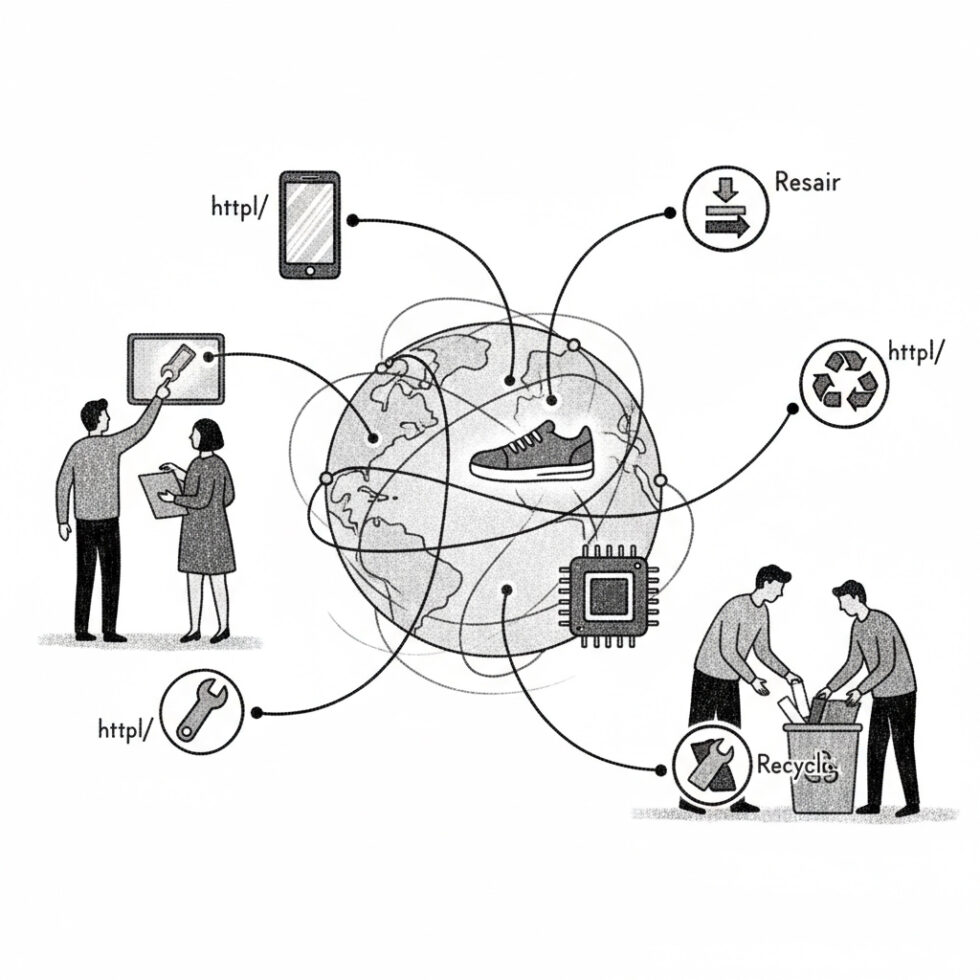
Scan a small QR code on a jacket and see when it was made, what it’s made of, and how to wash and mend it. Tap an NFC tag on a power tool to fetch the exact battery part number and a local repair shop that stocks it. Show a buyer your watch’s history—service dates, authenticity checks, and warranty—without sharing your name. These scenarios are the promise of Digital Product Passports (DPPs): durable, portable data stitched to the things we use every day.
Unlike marketing pages that vanish when a product line ends, a DPP is a persistent, structured record tied to the product itself. It travels with the item from factory to recycling bin, gathering facts and useful documents along the way. And because the passport lives at a link—readable by phones and machines—it can adapt to who is asking and why.
What a Digital Product Passport Is (and Isn’t)
A Digital Product Passport is a bundle of trustworthy data connected to a unique identifier for a product, a batch, or a component. That identifier is carried by something you can scan or tap, most often a QR code, RFID label, or NFC tag. The link behind that code points to a record that can display different information depending on the context: care instructions for a customer, compliance details for customs, a bill of materials for a repair center, or recycling directions for a waste facility.
Think of it as a living spec sheet plus a history log. It is not marketing fluff, and it is not a private tracking system that silently profiles you. A well-designed DPP uses data minimization, role-based access, and clear consent if any ownership data is involved.
Why now
Several forces are converging. Regulators in Europe are setting requirements for product data transparency across categories. Brands want better recall management and anti-counterfeiting tools. Consumers want to repair and resell. Recyclers need materials information to handle goods safely. And the standards to make this work—product identifiers, event logs, and secure credentials—have matured enough to roll out at scale.
How It Works: IDs, Links, and Data Layers
Identifiers and carriers
To create a DPP, each item needs an identifier. There are several approaches:
- Per product model (SKU-level): One link for a model line. Useful for broad care guidance, less useful for authenticity and detailed history.
- Per batch: One link per production batch. Balances cost with traceability.
- Per serial number: One link per unit. Enables authenticity checks, personalized repair history, and precise recall actions.
The identifier is encoded in a carrier you can scan or tap:
- QR codes: Cheap, printable on labels, packaging, and even etched on metal. Great for consumer access and global reach.
- NFC tags: Chips embedded in products, tap-to-read, can store small data and enable encrypted features. Useful for high-value items and wearables.
- RFID: Often used in logistics for bulk scanning. Less about consumer access, more about supply chain visibility.
The URL as a router
Modern product links aren’t just webpages. With standards like GS1 Digital Link, a single URL can route to different content based on device type, language, or user role. That means the same QR code can open a friendly care page for customers, while an authorized repair partner’s app fetches a JSON record with torque specs and part numbers.
Static data vs. dynamic events
A DPP blends two kinds of information:
- Static data: Who made the product, materials used, care instructions, warranty terms, safety sheets, regulatory declarations, and environmental footprint calculations.
- Event data: Where and when it was assembled, shipped, authenticated, updated, serviced, resold, and eventually recycled. These are time-stamped entries appended over the product’s life.
Event data is often recorded in a standardized log such as EPCIS, which lets different companies—manufacturers, logistics providers, retailers, repair shops—add entries in compatible formats.
Access control without friction
Not everyone should see everything. A well-planned DPP uses role-based views and verifiable credentials to share just what’s needed. A consumer might see a repair video and authenticity check. A recycler might get a detailed material breakdown including any hazardous components. A brand’s quality team may access batch-level analytics. The same link can serve all of them, with privacy-respecting guardrails.
Who Needs DPPs and When
You’ll see DPPs first where regulations and business needs align. In the European Union, the Ecodesign for Sustainable Products Regulation is laying out data transparency expectations for product groups including textiles, electronics, and furniture. Battery passports are coming earlier for electric vehicles and industrial batteries, reflecting the urgency around safe handling and responsible sourcing.
Outside Europe, industry coalitions and forward-looking brands are adopting DPPs voluntarily to streamline service, cut support costs, and build trust in secondary markets. If you sell goods that last, travel, or get repaired, expect DPPs to become a baseline expectation within a few product cycles.
What’s Inside a Good Product Passport
For everyday users
- Care and usage: Clear instructions, safety notices, and short videos.
- Parts and consumables: Compatible items with precise identifiers and local availability.
- Authenticity check: A quick status that helps avoid counterfeits without exposing secrets.
- Warranty and returns: What’s covered, expiration dates, and simple claim steps.
For repair and service
- Exploded diagrams, fastener types, torque specs, adhesive removal steps.
- Firmware/driver matrix with supported versions and rollback guidance.
- Calibration procedures and test points.
- Service history entries with dates and work performed.
For resale and recycling
- Condition and grading guidelines to reduce disputes.
- Material composition down to coatings and adhesives when relevant.
- Disassembly steps and hazard notes for safe processing.
Beyond Compliance: Why Brands Will Want This
Regulation may push the first wave, but the pull is strong:
- Lower support costs: Fewer “Do you have the manual?” calls. Self-serve answers reduce warranty claims.
- Targeted recalls: A recall can be narrowed to affected serials with clear instructions at scan time.
- Anti-counterfeiting: Server-side checks and tamper-evident tags reduce fraud. Even a basic authenticity status decreases returns abuse.
- Circular revenue: Refurbished sales, trade-ins, and official parts become easier when the product carries its own documentation.
- First-party relationships: Opt-in registrations via the passport build a high-quality channel without cookies.
Designing the DPP Stack
1) Choose your identifier strategy
Serializing every unit unlocks the most value but adds operational work. If you’re new to product identification, start with batch-level links for traceability, then move to per-serial for high-value items or categories with frequent repairs. Make sure identifiers are unique, collision-resistant, and documented internally.
2) Pick the carrier and placement
QR codes are the fastest way to start. They print well, cost almost nothing, and are readable by any smartphone. For outdoor or high-wear products, consider laser-etching or molded-in codes. For premium goods (watches, tools, e-bikes), NFC adds tap convenience and can support cryptographic authenticity checks. Place carriers where users naturally look: near the power input, inside a pocket flap, or under a removable cover, with a small icon that signals “scan or tap for info.”
3) Structure your data model
Divide your DPP into layers:
- Public layer: Care info, basic specs, safety sheets, warranty terms.
- Partner layer: Repair docs, parts catalogs, diagnostic routines.
- Compliance layer: Declarations of conformity, restricted substances reports, environmental footprint summaries.
- Event layer: Manufacturing, shipping, service, and end-of-life events with timestamps and actors.
Use stable identifiers for parts and materials so they can be referenced across systems. Plan for localization early; a DPP is most useful when it automatically shows content in the user’s language.
4) Build the resolver and APIs
The resolver is the service that answers when someone scans the code. It should:
- Detect device type and language to serve the right experience.
- Support role-based access with tokens for partners.
- Offer a machine-readable API (e.g., JSON) for apps and logistics systems.
- Log minimal analytics for uptime and abuse detection without tracking users across products.
5) Secure by design
Protect against obvious threats without building a surveillance machine. Use short-lived tokens for partner access. Consider signed data snippets for authenticity status. Throttle requests to prevent scraping. If you issue ownership credentials, make them opt-in and portable; a user should be able to export and delete data easily. Keep personal data out of the default passport.
6) Make operations boring
Reliability wins. Set up print-and-verify stations so codes are scannable from day one. Train QA to check that each label resolves correctly. Create a process to update content when parts change. For returns and refurbishment, add simple apps that can append service events with a scan and a photo. The more you automate, the less friction your teams feel.
Trust, Privacy, and Authenticity
Who sees what
Design for the principle of least privilege. Most scans should show public, non-sensitive data. Deeper layers—service logs, diagnostic data, or compliance documents—should require explicit authorization. When a user wants to prove the item’s condition or authenticity, they can generate a one-time proof that reveals just what’s necessary to the buyer or service desk, and nothing more.
Counterfeit resistance
Static QR codes alone can be copied. You can strengthen authenticity with:
- Server-side checks: The resolver recognizes suspicious patterns (e.g., one code scanned in many countries simultaneously).
- Tamper-evident carriers: Labels that show removal or damage.
- NFC with cryptographic challenge: The chip proves it’s original without exposing secret keys.
Combine these with education: the DPP should explain how to check the product safely and what to do if something seems off.
Respect for people
Ownership and repair data can be sensitive. Set clear defaults: no personal data unless the user opts in, transparent consent prompts, and simple ways to revoke access. If you enable transfer of ownership, do it with privacy-preserving credentials that don’t leak who owned the product before.
Designing for Longevity and Repair
Repairable products sell better and stay out of landfills longer. A DPP makes repair practical by putting precise, current information in the right hands. For common fixes, short videos and annotated images help more than dense PDFs. For complex repairs, service centers need torque specs, part tolerances, and calibration steps. If the product uses software, list firmware compatibility by serial range, not just model name, and make older versions available with warnings.
For parts catalogs, use structured identifiers that stay stable across suppliers, and flag safe alternatives when a part is discontinued. If your product uses adhesives or uncommon fasteners, document removal steps and solvents that are safe for the materials involved. Clear, accessible information builds goodwill and reduces unsafe improvisation.
The Tricky Bits People Don’t Talk About
Link rot and long timelines
Products can live for decades. Websites do not. Plan for stable hosting and versioning. Avoid hard-coding years or short-lived URLs in your codes. Use a resolver architecture so you can change backends without reprinting labels. For very long-lived goods (appliances, tools), consider a minimal “offline card” stored in an NFC chip: basic specs, safety notes, and a support phone number, readable even if the online service is down.
Data accuracy and liability
Incorrect repair steps can cause harm. Build a review process with engineering sign-off and clear revision history. When you change guidance, mark what changed and why. Let users report errors with a single tap. For recycled materials content and environmental claims, use third-party verifications where possible and attach those attestations to the DPP. Err on the side of clarity and caution.
Small suppliers and costs
A passport should not be a big-company-only feature. To support small and medium businesses, offer simple label templates, entry-level tools, and shared resolver services. Batch-level passports may be enough for many categories, and you can upgrade later. Focus on the handful of data fields that actually get used by customers and partners, not on filling endless spreadsheets.
Case Sketches
An e-bike battery
A rider scans the QR on the battery housing. The DPP shows the purchase date, remaining warranty, compatible charger models, and a safety guide. A service partner logs a cell-balancing service, which updates the passport with a date and shop ID. When the battery reaches end of life, the recycler scans the same code, sees the chemistry, disassembly instructions, and safe handling notes, and logs the pack as processed. The brand uses aggregate, anonymized data from these events to improve the next model.
A winter jacket
Scan the fabric label’s QR. The DPP lists materials by panel and insulation, care instructions, and a mending tutorial for a torn cuff. A reseller app reads the passport to verify model and season, then attaches a condition grade. The new buyer taps the NFC tag to confirm authenticity and sees a localized care page that matches the detergent brands in their country.
A corded power drill
Inside the handle, a laser-etched QR links to the drill’s passport. The owner downloads the correct brush set’s part number and a step-by-step replacement guide. After the fix, the repair shop logs the service and tests the chuck runout, adding a pass/fail entry. Years later, the drill changes hands with a one-time link that shows service history without revealing the previous owner’s name.
Getting Started: A Practical Checklist
- Pick a pilot product with real repair or resale activity. Don’t start with a dead-simple item.
- Decide identification granularity: SKU, batch, or serial. Document the reasons.
- Design the label and placement. Test scanning under poor lighting and after wear.
- Draft the data model: public, partner, compliance, and event layers. Keep it minimal then expand.
- Choose a resolver with role-based views and a simple JSON API.
- Write the top five help docs users actually need (care, most common repair, warranty terms, parts list, safety).
- Set up print-and-verify at the factory. Make “scan every tenth unit” a standard QA step.
- Onboard one repair partner to append service events and give feedback.
- Measure a few outcomes: support tickets avoided, parts sales, resale disputes prevented.
- Iterate on content and access policies. Remove friction, add only the data that moves the needle.
Common Questions
Isn’t this the same as “content credentials” for media?
No. Content credentials label the origin and edits of digital media like images and videos. A product passport is about physical goods and their lifecycle: materials, service, compliance, and end-of-life handling. Both use structured data and verification, but they solve different problems.
Do I need blockchain?
No. Many successful DPP pilots use standard databases, APIs, and signed attestations. If you require shared trust across many companies that don’t fully trust each other, you might explore distributed ledgers. Start simple and add complexity only when needed.
What if a code is damaged or lost?
Redundancy helps. Put codes in two places or combine a visible QR with a hidden NFC tag. Teach support to reissue labels when a product comes in for service. Avoid making the product unusable if the code disappears; the passport is a convenience, not a lock.
Will customers actually scan this?
They will if the result is immediately useful. Prioritize quick wins: a repair tip, a compatible part, or a warranty check in two taps. Avoid signup walls for basic information. The more helpful it is, the more it gets used.
What Good Looks Like
The best DPPs feel invisible until you need them. They load fast. They answer questions clearly. They work from any phone, in the right language, and don’t ask for an account unless there’s a real benefit. For partners, they plug into existing tools with a straightforward API. For your teams, they reduce headaches rather than adding new ones.
Most of all, a strong passport treats the user with respect. It keeps their data private, explains how authenticity is checked, and invites them to fix and enjoy the product for longer. That respect builds trust—and trust turns one sale into a long relationship that spans repairs, upgrades, and resales.
Where This Is Headed
As more goods carry useful data, everyday life gets a bit easier. Renting a tool can include a quick health check at pickup. A neighborhood repair cafe can pull up documentation for whatever shows up on the table. Municipal recycling centers can process complex items more safely. And the gray zone between “new” and “trash” fills with reliable options: refurbished, certified pre-owned, mended, upgraded.
We’re still at the beginning. Standards are settling, and tooling is improving. But the direction is clear: your belongings will have a link, and that link will make repair, resale, and recycling a normal part of product life. When the information is open, structured, and respectful, everyone wins—the maker, the buyer, and the planet.
Summary:
- Digital Product Passports tie structured, useful data to physical goods via QR, NFC, or RFID.
- A single link can serve different audiences: consumers, repairers, recyclers, and compliance teams.
- Strong DPPs blend static specs with dynamic event logs, using role-based access and minimal personal data.
- Brands benefit through lower support costs, targeted recalls, anti-counterfeiting, and circular revenue.
- Start with a pilot: pick a product, choose an identifier strategy, design the label, and build a simple resolver and API.
- Plan for longevity: stable links, versioned content, and offline fallbacks for long-lived goods.
- Privacy and authenticity matter; use least-privilege access and, where needed, cryptographic checks.
- The trend is accelerating, with regulations in the EU and voluntary adoption elsewhere.





